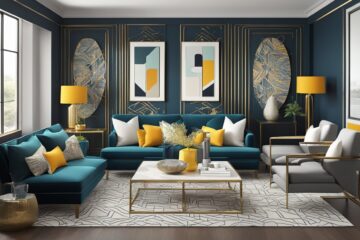Are you an aspiring interior designer seeking guidance on designing the perfect transition space? Look no further! Transitional style is a popular trend among modern and contemporary homes, blending characteristics from classic and contemporary styles. Its flexibility makes this approach to decorating ideal for those who value timelessness in design balanced with modern touches. In this article, we’ll break down the transitional style’s features, so you can quickly bring it into your home. Keep reading to learn what sets the transitional style apart and how to apply its principles to create beautiful spaces that stand the test of time.
Understand the Basics of Transitional Style Design
Transitional style design is a popular approach to interior design, blending traditional and modern elements. Its goal is to create an atmosphere that feels both timeless and fresh. To successfully capture this style, utilize simple shapes but give them a more dynamic feel with bold colours, intricate crown moulding and tailored fabrics. Balance neutral hues with vibrant shades of yellow, blue or red. Incorporate texture-rich materials such as wicker furniture and sea-grass rugs. Add classic pieces like an upholstered sofa paired with a sleek glass table while introducing a touch of nature through potted plants or abstract art pieces depicting natural patterns like rolling hills. With these foundational elements, it’s easy to create a harmonious transitional style design that is captivating and comforting.
Identify Elements of Transitional Style
The transitional style combines traditional and modern elements to create two distinct looks that complement each other. When decorating a transitional space, the key is to balance these two style sensibilities. Items like furniture with clean lines and neutral upholstery, combined with eye-catching touches such as bright colours or textured carpets, make for a stunning cohesive look. Alongside this, it’s important to also incorporate accent pieces with ornaments and artwork for an inviting atmosphere. Aspiring interior designers can create interiors with timeless appeal by layering various elements ranging from eclectic heirlooms to contemporary decor.
a. Furniture Design
Furniture design is an essential element of interior design that helps create a unique and memorable setting for any room. Its functionality and aesthetic make furniture the focus of many interior design projects, allowing it to determine the look and feel of the entire space. Since furniture could be considered a reflection of personal style, it is essential to ensure that the pieces you choose add to the overall design while offering maximum comfort and utility. Understanding how each piece contributes to the space can help you creatively incorporate furniture into your room designs. With so many options out there, designers must be willing to experiment with different materials, styles, and shapes to create original pieces that fit the aesthetic of their project perfectly.
b. Colour Scheme
A dynamic colour scheme can make or break an interior design project. Complementary and analogous colours should be used strategically to create contrast, while shades and tints can add depth. Colour harmony should always be considered when selecting a colour palette so that the design has no harsh elements. Incorporating a centre point of contrast into the design with a pop of complementary colour will tie it all together and bring the desired effect to life. Each room should be designed with a specific mood or emotional effect in mind, and the right colours will help bring that emotion out of the space.
c. Lighting Design
The importance of lighting design for interior spaces is often overlooked, but it can make all the difference in achieving a modern and inviting feel. Light affects the ambience of a room, as well as the ability of the occupants to view details properly, carry out tasks in the space, and even feel energized or relaxed. As an interior designer, one should consider different aspects of lighting design such as type of light bulb, intensity levels of light, placement and angles of light fixtures to create optimal conditions for use within its designated purpose. By being strategic with lighting design features, it is possible to successfully set the right tone and atmosphere to make occupants feel warm and welcome and reflect on your overall design vision.
Analyze the Use of Texture and Pattern
As an interior designer, it is essential to use an appropriate combination of textures and patterns to create the desired atmosphere. Textures and patterns can define a room’s purpose and create an inviting, creative environment. You can go beyond choosing a simple matching palette by analyzing which fabrics, walls, fixtures, carpets and other items best suit your design space. Proper texture and pattern combinations can reveal subtle details in a room’s design. Done correctly, this will add flair and sophistication to any setting or create a bold statement for all to admire.
Explore Space Planning Considerations for Transitional Style Interiors
Designers must know the flux between traditional and modern aesthetics when planning rooms. There are several key space planning considerations to create harmonious transitional style interiors. For example, the relationship between light, texture, and colour can have a powerful effect when mixing traditional with modern elements. Furniture placement is another important factor; arranging pieces for socializing and functionality requires careful thought and creative problem-solving. Lastly, balancing decorative details is pivotal; an equal blend of soft curves and geometric shapes creates visual interest that flows smoothly throughout the entire space. Professionals can create unique spaces where comfort and style come together by considering these essential transition points while designing an interior.
Incorporate Accessories to Add Interest and Depth to the Room
Accessories are often overlooked when interior designing, but adding them to each room can make a huge difference! Accessorizing is an easy way to add texture, colour, and visual interest to any space. Incorporating lamps and rugs of various sizes and shapes, vibrant art pieces, cosy textiles such as throw pillows and blankets, and decorative items like sculptures or books can create depth and dimension in the room. Make sure to choose accessories that fit your vision for the design scheme and that match the rest of the items in the space for a cohesive look.
Learn How to Create Balance in Transitional Interiors
Creating a balance between traditional and modern pieces when designing interiors is a tricky feat, but it’s also gratifying. It requires understanding how the elements in a room send visual messages, like contrast, texture and colour theory. Nailing these subtleties can turn the most ordinary room into an awe-inspiring space. With the proper techniques and products, you can use transitional interiors to craft gorgeous designs that will wow your clients for years. Learning to create balance as an interior designer is a journey worth taking; reading up on essential design principles is just the beginning.


